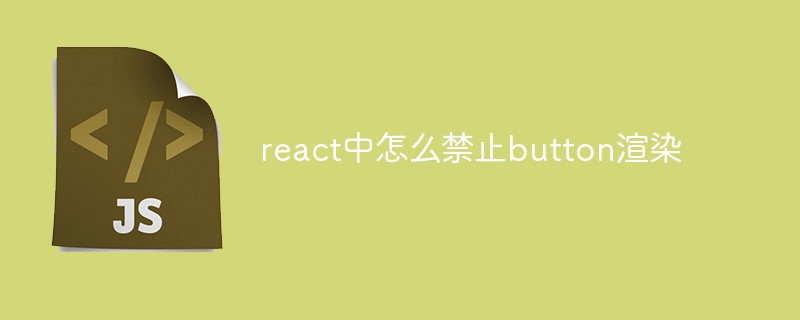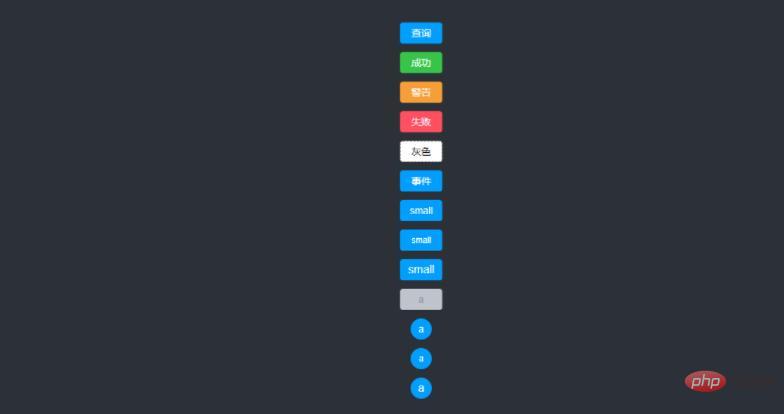How to disable button rendering in react
How to disable button rendering in react: 1. Open the corresponding js code file; 2. Find "const flags = true;

The operating environment of this tutorial: Windows 10 system, react18.0.0 version, Dell G3 computer.
How to disable button rendering in react?
The disabled and enabled states of the button button in react
disabled is false and is the enabled state
// 启用状态
const flags = true;
<Button disabled={flags}/>disabled is true and is the disabled state
// 禁用状态
<Button disabled/>
// 禁用状态2 变量控制
const flags = false;
<Button disabled={flags}/> Let’s expand and talk about React custom components--Button
This is the main js code
import React, { Component } from 'react'
import "./dist/index.css";
import PropTypes from "prop-types";
import classnames from "classnames";
class Button extends Component {
constructor(props) {
super(props);
this.state = { }
}
handleClick = () => {
if (!this.props.onClick) return;
this.props.onClick();
};
render() {
//为了能让 Button 组件有多个样式选择,于是安装 classnames 插件来帮助切换类名来切换样式:
const ClassName = classnames({ //根据父组件传进来的 size 来判断使用什么类名
"btn": true,
[`btn_${this.props.type}`]: true,
[`btn_${this.props.size}`]: true,
"btn_disabled": this.props.disabled,
"btn_circle": this.props.circle,
});
return (
<button
className = {ClassName}
onClick = {this.handleClick}
>
{this.props.children}
</button>
);
}
}
// 组件的默认属性
Button.defaultProps = {
children: "Button",
type: "primary",
size: "default",
disabled: false,
circle: false,
};
// 使用propTypes 进行组件属性的检查
Button.propTypes = {
children: PropTypes.string,
type: PropTypes.oneOf(["primary", "success", "warning", "danger", "info"]),
size: PropTypes.oneOf(["default", "small", "large"]),
disabled: PropTypes.bool,
circle: PropTypes.bool,
};
export default Button;This is the style code
@bG-0: #fff;
@bF-1: #c0c4cc;
@PRIMARY: #409eff;
@SUCCESS: #67c23a;
@DANGER: #f65c6c;
@WARNING: #e6a23c;
@INFO: #909399;
@FONTSIZE: 14px;
@radius: 4px;
@btnBorderRadius: 4px;
@btnBorder: 1px solid transparent;
@btnMargin: 0 8px 12px 0;
@btnFontSize: 14px;
@btnLargeFontSize: 16px;
@btnSmallFontSize: 12px;
@btnPadding: 4px 15px;
@btnLargePadding: 6.4px 15px;
@btnSmallPadding: 1px 7px;
@btnDisabledCol: #909399;
.btn {
width: 60px;
height: 30px;
border-radius: @btnBorderRadius;
border: @btnBorder;
outline: none;
appearance: none;
text-align: center;
margin: @btnMargin;
cursor: pointer;
justify-content: center;
align-items: center;
text-align: center;
&_primary {
background-color: @PRIMARY;
color: @bG-0;
&:hover {
opacity: 0.8;
}
}
&_success {
background: @SUCCESS;
color: @bG-0;
&:hover {
opacity: 0.8;
}
}
&_danger {
background: @DANGER;
color: @bG-0;
&:hover {
opacity: 0.8;
}
}
&_warning {
background: @WARNING;
color: @bG-0;
&:hover {
opacity: 0.8;
}
}
&_info {
background-color: @bG-0;
color: black;
border: 1px dashed #999;
&:hover {
opacity: 0.8;
}
}
&_disabled {
background-color: @bF-1;
color: @btnDisabledCol;
cursor: not-allowed;
&:hover {
opacity: 1;
}
}
&_circle {
padding: 0;
font-size: 16px;
text-align: center;
width: 30px;
height: 30px;
overflow: hidden;
border-radius: 50%;
word-break: break-all;
}
&_large {
font-size: @btnLargeFontSize;
}
&_default {
font-size: @btnFontSize;
}
&_small {
font-size: @btnSmallFontSize;
}
}Final quote example
import './App.css';
import Button from './component/Button/index'
function App() {
const handleClick = () => {
alert('我是组件');
}
return (
<div className="App">
<header className="App-header">
<Button>查询</Button>
<Button type = "success">成功</Button>
<Button type = "warning">警告</Button>
<Button type = "danger">失败</Button>
<Button type = "info">灰色</Button>
<Button onClick={ handleClick }>事件</Button>
<Button size='default'>small</Button>
<Button size='small'>small</Button>
<Button size='large'>small</Button>
<Button disabled={true} >a</Button>
<Button size='default' circle={true} >a</Button>
<Button size='small' circle={true} >a</Button>
<Button size='large' circle={true} >a</Button>
</header>
</div>
);
}
export default App;Achievements

Leave a good impression on yourself, there are still many shortcomings, I hope everyone can make progress together
Recommended Study: "react video tutorial"
The above is the detailed content of How to disable button rendering in react. For more information, please follow other related articles on the PHP Chinese website!

Hot AI Tools

Undresser.AI Undress
AI-powered app for creating realistic nude photos

AI Clothes Remover
Online AI tool for removing clothes from photos.

Undress AI Tool
Undress images for free

Clothoff.io
AI clothes remover

Video Face Swap
Swap faces in any video effortlessly with our completely free AI face swap tool!

Hot Article

Hot Tools

Notepad++7.3.1
Easy-to-use and free code editor

SublimeText3 Chinese version
Chinese version, very easy to use

Zend Studio 13.0.1
Powerful PHP integrated development environment

Dreamweaver CS6
Visual web development tools

SublimeText3 Mac version
God-level code editing software (SublimeText3)

Hot Topics
 Guide to React front-end and back-end separation: How to achieve decoupling and independent deployment of front-end and back-end
Sep 28, 2023 am 10:48 AM
Guide to React front-end and back-end separation: How to achieve decoupling and independent deployment of front-end and back-end
Sep 28, 2023 am 10:48 AM
React front-end and back-end separation guide: How to achieve front-end and back-end decoupling and independent deployment, specific code examples are required In today's web development environment, front-end and back-end separation has become a trend. By separating front-end and back-end code, development work can be made more flexible, efficient, and facilitate team collaboration. This article will introduce how to use React to achieve front-end and back-end separation, thereby achieving the goals of decoupling and independent deployment. First, we need to understand what front-end and back-end separation is. In the traditional web development model, the front-end and back-end are coupled
 How to build a reliable messaging app with React and RabbitMQ
Sep 28, 2023 pm 08:24 PM
How to build a reliable messaging app with React and RabbitMQ
Sep 28, 2023 pm 08:24 PM
How to build a reliable messaging application with React and RabbitMQ Introduction: Modern applications need to support reliable messaging to achieve features such as real-time updates and data synchronization. React is a popular JavaScript library for building user interfaces, while RabbitMQ is a reliable messaging middleware. This article will introduce how to combine React and RabbitMQ to build a reliable messaging application, and provide specific code examples. RabbitMQ overview:
 React Router User Guide: How to implement front-end routing control
Sep 29, 2023 pm 05:45 PM
React Router User Guide: How to implement front-end routing control
Sep 29, 2023 pm 05:45 PM
ReactRouter User Guide: How to Implement Front-End Routing Control With the popularity of single-page applications, front-end routing has become an important part that cannot be ignored. As the most popular routing library in the React ecosystem, ReactRouter provides rich functions and easy-to-use APIs, making the implementation of front-end routing very simple and flexible. This article will introduce how to use ReactRouter and provide some specific code examples. To install ReactRouter first, we need
 PHP, Vue and React: How to choose the most suitable front-end framework?
Mar 15, 2024 pm 05:48 PM
PHP, Vue and React: How to choose the most suitable front-end framework?
Mar 15, 2024 pm 05:48 PM
PHP, Vue and React: How to choose the most suitable front-end framework? With the continuous development of Internet technology, front-end frameworks play a vital role in Web development. PHP, Vue and React are three representative front-end frameworks, each with its own unique characteristics and advantages. When choosing which front-end framework to use, developers need to make an informed decision based on project needs, team skills, and personal preferences. This article will compare the characteristics and uses of the three front-end frameworks PHP, Vue and React.
 Integration of Java framework and front-end React framework
Jun 01, 2024 pm 03:16 PM
Integration of Java framework and front-end React framework
Jun 01, 2024 pm 03:16 PM
Integration of Java framework and React framework: Steps: Set up the back-end Java framework. Create project structure. Configure build tools. Create React applications. Write REST API endpoints. Configure the communication mechanism. Practical case (SpringBoot+React): Java code: Define RESTfulAPI controller. React code: Get and display the data returned by the API.
 How to use React to develop a responsive backend management system
Sep 28, 2023 pm 04:55 PM
How to use React to develop a responsive backend management system
Sep 28, 2023 pm 04:55 PM
How to use React to develop a responsive backend management system. With the rapid development of the Internet, more and more companies and organizations need an efficient, flexible, and easy-to-manage backend management system to handle daily operations. As one of the most popular JavaScript libraries currently, React provides a concise, efficient and maintainable way to build user interfaces. This article will introduce how to use React to develop a responsive backend management system and give specific code examples. Create a React project first
 Vue.js vs. React: Project-Specific Considerations
Apr 09, 2025 am 12:01 AM
Vue.js vs. React: Project-Specific Considerations
Apr 09, 2025 am 12:01 AM
Vue.js is suitable for small and medium-sized projects and fast iterations, while React is suitable for large and complex applications. 1) Vue.js is easy to use and is suitable for situations where the team is insufficient or the project scale is small. 2) React has a richer ecosystem and is suitable for projects with high performance and complex functional needs.
 What closures does react have?
Oct 27, 2023 pm 03:11 PM
What closures does react have?
Oct 27, 2023 pm 03:11 PM
React has closures such as event handling functions, useEffect and useCallback, higher-order components, etc. Detailed introduction: 1. Event handling function closure: In React, when we define an event handling function in a component, the function will form a closure and can access the status and properties within the component scope. In this way, the state and properties of the component can be used in the event processing function to implement interactive logic; 2. Closures in useEffect and useCallback, etc.






